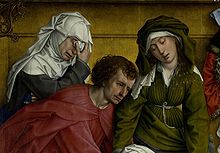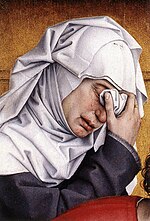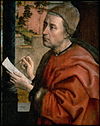The Descent from the Cross (van der Weyden)
| The Descent from the Cross | |
|---|---|
| File:Rogier van der Weyden Deposition.jpg | |
| Artist | Rogier van der Weyden |
| Year | c. 1435-38 |
| Type | Oil on oak panel |
| Dimensions | 2.18 m × 2.62 m (7 ft 2 in × 8 ft 7 in) |
| Location | Museo del Prado, Madrid |
The Descent from the Cross (or Deposition of Christ, or Descent of Christ from the Cross) is a panel painting by the Flemish artist Rogier van der Weyden created c. 1435-38, of the Deposition of Christ now in the Prado, Madrid. The work shows the crucified Christ being lowered from the cross, his lifeless body held by Joseph of Arimathea and Nicodemus.
History
The painting was commissioned by the Greater Guild of Crossbowmen of Leuven in today's Belgium - and was originally installed in the Chapel of Our Lady Without the Walls.[1][2] The tiny crossbows in the side spandrels of the picture reflect the original patronage.[3] The art historians Dirk De Vos and Lorne Campbell both give an approximate date of 1435 for the painting. De Vos argues that the earliest known copy of Van der Weyden's Deposition, the Edeleheere triptych in Louvain, may have been completed by 1435, certainly before 1443. Therefore Van der Weyden's painting must pre-date it.[1] The painting was exchanged around 1548 for a copy by Michael Coxcie and an organ. The new owner was Mary of Austria,[1] sister of Holy Roman Emperor, Charles V, for whom she governed the Habsburg Netherlands. The painting was initially installed in Mary's castle at Binche, where it was seen by a Spanish courtier, Vicente Alvárez, who in 1551 wrote this description:
It was the best picture in the whole castle and even, I believe, in the whole world, for I have seen in these parts many good paintings but none that equalled this in truth to nature or devoutness. All those who have seen it were of the same opinion.[1]
Alvárez had accompanied the future king of Spain, Philip II. Philip transported the painting to Spain, where it was installed in his hunting lodge, El Pardo.[1] On April 15, 1574, the painting was recorded in the inventory of the monastery palace which Philip had founded, San Lorenzo de El Escorial: "A large panel on which is painted the deposition from the cross, with our Lady and eight other figures ... by the hand of Maestre Rogier, which used to belong to the queen Mary".[4]
In 1936, when the Spanish Civil War broke out, many religious works of art were destroyed. The Spanish Republic took action to protect its artistic masterpieces. The Descent from the Cross was evacuated from El Escorial to Valencia. In the summer of 1939, it was was brought to Switzerland by train, where the Spanish Republic publicised its plight with an exhibition: “Masterpieces of the Prado”, held in the Musée d’Art et d’Histoire in Geneva. In September, the painting returned to the Museo del Prado in Madrid, where it has remained.[5][6]
Narrative of the Descent from the Cross
In their accounts of the descent of Christ's body from the Cross, the evangelists relate the story only in connection with the Entombment of Christ. According to Matthew (27:57-60), Mark (15:42-47) and Luke (23:50-56), Joseph of Arimathea took Christ’s body and prepared it for burial. John (19:38-42) adds one assistant, Nicodemus. None of these accounts mention Mary at all.
During the Middle Ages, the narrative of the Passion became more elaborate, and more attention was paid to the role of Christ's mother. One example is the anonymous 14th century text, Meditationes de Vita Christi, perhaps by Ludolph of Saxony. Barbara Lane has suggested that this passage from the Vita Christi might lie behind many painted accounts of the Deposition,[7] including Rogier's:
Then the lady reverently receives the hanging right hand and places it against her cheek gazes upon it, and kisses it with heavy tears and sorrowful sighs.
Structure of the painting

Lorne Campbell has identified the figures in the painting as (from left to right): Mary Cleophas (half-sister to the Virgin Mary); Saint John the Evangelist; Mary Salome (in green, another half-sister of the Virgin Mary); The Virgin Mary (swooning); the body of Jesus Christ; Nicodemus (in red); the young man on the ladder is either a servant of Nicodemus or of Joseph of Arimathea; Joseph of Arimathea (in field-of-cloth-of-gold robes, the most sumptuous costume in the painting); the bearded man behind Joseph holding a jar is probably another servant (The jar that he holds is likely to be the emblem of the Magdalen, containing the ‘pound of ointment of spikenard, very costly’, with which she anointed the feet of Jesus.); and Mary Magdalene who adopts a dramatic pose on the right of the painting.[8]
There is disagreement between art historians as to the representation of Joseph of Arimathea and Nicodemus. In his Rogier van der Weyden: the Complete Works, Dirk de Vos identifies Joseph of Arimathea as the man in red supporting Christ's body, and Nicodemus as the sumptuously dressed man supporting Christ's legs, the opposite of Campbell's identification.[9]
Formal qualities and emotional impact
What makes the work unique for the period is the swoon of the Virgin Mary, collapsing in a pose that mirrors that of her son, right down to the two figures that hold her as she falls. This pose was entirely new for Early Netherlandish art; an innovation of van der Weyden.[10] The sentiment, however, is a direct reflection of the mystical devotion expressed by Thomas à Kempis' popular treatise Imitatio Christi, first published in 1418. The text, just as the image here, invites the reader or viewer to personally identify with the suffering of Christ and Mary. The doctrines of Denis the Carthusian also emphasized the significance of the Virgin Mary and her belief in Christ at the moment of his death. Denis expresses the conviction that the Virgin Mary was near death when Christ gave up his spirit; Van der Weyden's painting powerfully conveys this idea.[11]

The shape of the crossbow can be seen in the outline of Christ's body, reflecting the patronage of the Greater Guild of Crossbowmen.[13] Powell argues that in medieval theology, a metaphor would compare Christ on the cross to a taut crossbow: "[this] bow consists of a piece of wood or horn and a string, which represents our Saviour. The string can represent his most holy body, which was miraculously strained and stretched in the suffering of his Passion."[14] The fourteenth century poet, Heinrich von Neustadt, wrote: "He was laid out on the cross:/There were his pure limbs/and his arms drawn/Like the string of a bow." In Rogier’s Deposition, Christ’s removal from the cross is pictured as the relaxation of a bow that has released its arrow.[15]
Dirk de Vos suggests that the artist wished to evoke a gigantic, carved altarpiece with polychrome figures, and is thus pushing painting forward as a rival to sculpture. The corners are filled with carved tracery, also gilded, while the presentation of living figures on a stage is really a tableau vivant, which in turn imitates a sculptural group. There is a sense of condensed movement in a single instant. Mary faints but is already confirmed in her swoon by St John who rushes to her assistance. The man on the ladder lowers the body but it is already held by Joseph of Arimathea, and Nicodemus who wants to carry it away to the right. Nicodemus’s movement transforms the weeping Magdalene into a statue frozen in time. De Vos writes: “Time seems to have solidified into a composition. And what a composition. Interplay of undulating lines, swaying poses and counterposes of figures have rightly been compared to technique of counterpoint in polyphonic music.”[16]
De Vos also analyses the spatial complexity of the painting. The action takes place in a space barely a shoulder-width deep, yet there are no fewer than five levels of depth within the painting: the Virgin Mary at the front, the body of Christ, the bearded figure of Joseph of Arimathea, the cross and the assistant on his ladder. At the "back" of the painting, the assistant breaks the spatial illusion, by allowing one of the two nails he holds to protrude in front of the painted niche.[17]
The image can be read as a petrified synthesis of all the stages during and after the Descent from the Cross: the lowering of the corpse, the Deposition, the Lamentation and the Entombment. Christ’s feet appear to be still nailed together, while the spread of His arms retains the position of His body on the Cross. Christ’s body is shown as if held out for the concentrated gaze of the viewer. Joseph of Arimathea looks across the body towards the skull of Adam. Joseph appears as a sumptuously dressed burgher and has the most portrait-like appearance of the figures in the painting; his gaze links the hands of Christ and his mother, the new Adam and Eve, with the skull of Adam. Thereby visualising the essence of the Redemption.[18]
Campbell argues that the key to the work is not naturalism in the detail of the painting, but rather the use of distortion to induce a sense of unease in the viewer. By including completely irrational details and by distorting otherwise extremely faithful images of reality, the artist shocks us into reconsidering our attitudes to his subjects. Campbell suggests that, in certain ways, Rogier has more in common with Matisse or the Picasso of Guernica than with his contemporaries.[8]
An example of the extraordinary play with the illusion of space in this painting can be seen in the young man at the top of the ladder holding the nails withdrawn from Christ's body. Campbell points out that this servant behind the cross appears to have caught his sleeve in the wooden tracery depicted at the top of the painting. The head of one of the bloody nails that he holds is in front of the fictional wooden picture frame, though the point of the other nail is behind the tracery.[8] Campbell argues that, in order to prevent these spatial distortion from becoming too obvious, Rogier has taken pains to conceal the principal pictorial junctions in the picture. For example, the ladder is in an impossible perspective: its top is behind the cross while its foot appears to be in front of the cross. To conceal the points at which the Cross and the ladder meet the landscape, Rogier has greatly lengthened the Virgin’s left leg, so that her left foot and mantle cover the base of the Cross and one upright of the ladder.[8]
Later influence
Since its creation, this work has been often copied and was extremely influential; within van der Weyden's own lifetime it was considered an important and unique work of art.[19] Von Simson claims that "no other painting of its school has been copied or adapted so often".[20] In 1565, the Antwerp publisher Hieronymus Cock published an engraving by Cornelis Cort, the first graphic reproduction of Rogier’s Descent, which is inscribed with the words ‘M. Rogerij Belgiae inuentum’. Cock’s engraving is the earliest record of Rogier’s name in association with the Deposition.[21]
Notes
- ^ a b c d e De Vos, 185-186
- ^ "Descent from the Cross, Prado website".
- ^ Snyder, Northern Renaissance, 118
- ^ Powell, (2006) The Errant Image: Rogier van der Weyden's Deposition from the Cross and its Copies, 552
- ^ Arte protegido/Protected Art, catalogue of exhibition at the Palais des Nations, Geneva, March-April 2005, published by Museo Nacional del Prado
- ^ Museo del Prado, Catálogo de las pinturas, 1996, 448, Ministerio de Educación y Cultura, Madrid, ISBN 8487317537
- ^ Lane, Altars and Altarpieces, 89
- ^ a b c d Lorne Campbell, "The New Pictorial Language of Rogier van der Weyden", in Rogier van der Weyden, Master of Passions, ed. Campbell & Van der Stock, 2009, 2-64
- ^ De Vos, 21
- ^ Snyder, 118
- ^ von Simson, 14-15.
- ^ Campbell, 34
- ^ Powell, (2006) The Errant Image: Rogier van der Weyden's Deposition from the Cross and its Copies. 544
- ^ Gottfried von Admont, ‘Arcus, qui ex ligno et chorda, vel cornu et chorda constat, eumdem Dominum ac Redemptorem nostrum nobiliter demonstrat. Potest enim designari per chordam sanctissima ejus caro, diversis tribulationum angustiis mirabiliter attracta atque distenta’. Patrologia Latina: The Full-Text Database, Alexandria, 1996, vol. 174, 1150A-B. Quoted and discussed in Frederick P. Pickering, Das gotische Christusbild: Zu den Quellen mittelalterlicher Passionsdarstellungen, Euphorion: Zeitschrift fur Literaturgeschichte, 47, 1953, 31–2.
- ^ Powell, (2006) The Errant Image: Rogier van der Weyden's Deposition from the Cross and its Copies, 545
- ^ De Vos, 14–16.
- ^ De Vos, 15
- ^ De Vos, 22
- ^ von Simson, 9-10
- ^ von Simson, 9
- ^ Powell, (2006) The Errant Image: Rogier van der Weyden's Deposition from the Cross and its Copies, 550
Bibliography
- Campbell, Lorne & Van der Stock, Jan, Rogier van der Weyden: 1400-1464. Master of Passions. Leuven: Davidsfonds, 2009. ISBN 978-90-8526-105-6.
- De Vos, Dirk. Rogier Van Der Weyden: The Complete Works. Harry N. Abrams, 1999. ISBN 0-8109-6390-6
- Lane, Barbara. The altar and the altarpiece: sacramental themes in early Netherlandish painting. Harper & Row, 1984. ISBN 0-0643-5000-2
- Powell, Amy. "The Errant Image: Rogier van der Weyden's Deposition from the Cross and its Copies". Art History, Vol. 29, No. 4. 540–552
- von Simson, Otto G., " Compassio and Co-redemptio in Roger van der Weyden's Descent from the Cross". The Art Bulletin, Vol. 35, No. 1, March, 1953. 9–16.
- Snyder, James, Northern Renaissance Art; Painting, Sculpture, The Graphic Arts from 1350 to 1575. Saddle River, NJ: Prentice Hall, 2005.
External links
![]() Media related to Descent from the Cross by Rogier van der Weyden (Prado) at Wikimedia Commons
Media related to Descent from the Cross by Rogier van der Weyden (Prado) at Wikimedia Commons

